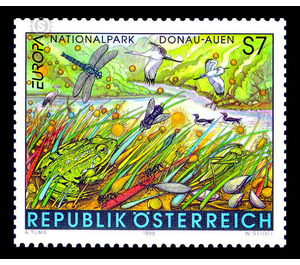CEPT - Austria / II. Republic of Austria 1999 - 7 Shilling
Theme: Animals
| Country | Austria / II. Republic of Austria |
| Issue Date | 1999 |
| Face Value | 7.00 |
| Stamp Type | Commemorative |
| Item Type | Stamp |
| Chronological Issue Number | 1631 |
| Chronological Chapter | OOS-OE2 |
| SID | 554555 |
| In 67 Wishlists | |
The Donau-Auen National Park stretches along the Danube from Vienna to the state border in the east of Lower Austria. Here, the largest contiguous, ecologically largely intact floodplain landscape of Central Europe is protected and secures a huge variety of already often endangered habitats, plant and animal species. The Danube regulation towards the end of the 19th century dramatically changed the natural balance of this floodplain landscape. The greatest threat to this area threatened in 1984 with the planned construction of the power plant Hainburg. The non-violent occupation of the Stopfenreuther Au by thousands of demonstrators prevented a destruction of today's national park area. With the signing of a State Treaty on October 27, 1997 between the Republic of Austria and the countries of Vienna and Lower Austria, the National Park was opened. Today it covers a size of approximately 9,300 hectares, with an extension to 11,500 hectares is planned. Protecting their habitats is of the utmost importance for the sustainable preservation of the biodiversity of animals and plants. In floodplain landscapes this is only possible by maintaining and promoting the dynamics of the river. Only in the area of the national park does the free-flowing Danube have the potential to make the floodplain a large area in the long term.


